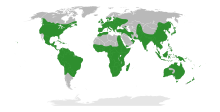Sapindaceae
Sapindaceae
Jump to navigation
Jump to search
| Soapberry family | |
|---|---|
 | |
Litchi chinensis leaves and fruit | |
Scientific classification | |
| Kingdom: | Plantae |
Clade: | Angiosperms |
Clade: | Eudicots |
Clade: | Rosids |
| Order: | Sapindales |
| Family: | Sapindaceae Juss. |
Subfamilies | |
Dodonaeoideae | |
Diversity | |
1,900+ species in ca. 140 genera | |
 | |
| The range of Sapindaceae. | |
The Sapindaceae is a family of flowering plants in the order Sapindales known as the soapberry family. It contains 138 genera[2] and 1858 accepted species, including maple, ackee, horse chestnut and lychee.
Sapindaceae species occur in temperate to tropical regions, many in laurel forest habitat, throughout the world. Many are laticiferous, i.e. they contain latex, a milky sap, and many contain mildly toxic saponins with soap-like qualities in either the foliage and/or the seeds, or roots.[citation needed] The largest genera are Serjania, Paullinia, Acer and Allophylus.[citation needed]
The largely temperate genera formerly separated in the families Aceraceae (Acer, Dipteronia) and Hippocastanaceae (Aesculus, Billia, Handeliodendron) were included within a more broadly circumscribed Sapindaceae by the APG.[citation needed] Recent research has confirmed the inclusion of these genera in Sapindaceae.[3][4]
Contents
1 Characteristics
2 Classification
3 Notable species
4 References
5 External links
Characteristics[edit]
Plants of this family have a variety of habits, from trees to herbaceous plants or lianas. Their leaves usually spirally alternate, sometimes (in Acer, Aesculus, and a few other genera) opposite. They are most often pinnately compound, sometimes palmately compound as in Aesculus, or just palmate as in Acer. The petiole has a swollen base and lacks stipules.[3] Some genera and species have laurel forest foliage due to convergent evolution.[citation needed]

Dodonaea viscosa flowers
Flowers are small and unisexual, or functionally unisexual, though plants may be either dioecious or monoecious. They are usually grouped in cymes grouped in panicles. They most often have four or five petals and sepals (petals are absent in Dodonaea). The stamens range from four to ten, usually on a nectar disc between the petals and stamen, their filaments are often hairy. The most frequent number is eight, in two rings of four. The gynoecium contains two or three carpels, sometimes up to six. There is usually only one style with a lobed stigma. Most often pollinated by birds or insects, with a few species pollinated by wind.[3]
The fruits are fleshy or dry. They may be nuts, berries, drupes, schizocarps, capsules (Bridgesia), or samaras (Acer). The embryos are bent or coiled, without endosperm in the seed, but frequently with an aril.[3]
Classification[edit]

Rambutan fruits.
Sapindaceae are related to Rutaceae, and both are usually placed in an order Sapindales or Rutales, depending on whether they are kept separate and which name is used for the order.[3] The most basal member appears to be Xanthoceras.[citation needed] Some authors maintain some or all of Hippocastanaceae and Aceraceae, although this may result in paraphyly.[3][4] The former Ptaeroxylaceae, now placed in Rutaceae, were sometimes placed in Sapindaceae.[5] The family is divided into 4 subfamilies.[citation needed]
Notable species[edit]

Alupag (Dimocarpus didyma) fruits
Sapindaceae includes many species of economically valuable tropical fruit, including the lychee, longan, pitomba, guinip/mamoncillo, korlan, rambutan, pulasan and ackee. Other products include guarana, soapberries and maple syrup.
Some species of Maple and Buckeye are valued for their wood, while several other genera, such as Koelreuteria, Cardiospermum and Ungnadia, are popular ornamentals. Schleichera trijuga is the source of Indian macassar oil. Saponins extracted from the drupe of Sapindus species are effective surfactants and are used commercially in cosmetics and detergents.[6]
References[edit]
^ "Sapindaceae Juss., nom. cons". Germplasm Resources Information Network. United States Department of Agriculture. 2003-01-17. Archived from the original on 2009-05-06. Retrieved 2009-04-11..mw-parser-output cite.citationfont-style:inherit.mw-parser-output .citation qquotes:"""""""'""'".mw-parser-output .citation .cs1-lock-free abackground:url("//upload.wikimedia.org/wikipedia/commons/thumb/6/65/Lock-green.svg/9px-Lock-green.svg.png")no-repeat;background-position:right .1em center.mw-parser-output .citation .cs1-lock-limited a,.mw-parser-output .citation .cs1-lock-registration abackground:url("//upload.wikimedia.org/wikipedia/commons/thumb/d/d6/Lock-gray-alt-2.svg/9px-Lock-gray-alt-2.svg.png")no-repeat;background-position:right .1em center.mw-parser-output .citation .cs1-lock-subscription abackground:url("//upload.wikimedia.org/wikipedia/commons/thumb/a/aa/Lock-red-alt-2.svg/9px-Lock-red-alt-2.svg.png")no-repeat;background-position:right .1em center.mw-parser-output .cs1-subscription,.mw-parser-output .cs1-registrationcolor:#555.mw-parser-output .cs1-subscription span,.mw-parser-output .cs1-registration spanborder-bottom:1px dotted;cursor:help.mw-parser-output .cs1-ws-icon abackground:url("//upload.wikimedia.org/wikipedia/commons/thumb/4/4c/Wikisource-logo.svg/12px-Wikisource-logo.svg.png")no-repeat;background-position:right .1em center.mw-parser-output code.cs1-codecolor:inherit;background:inherit;border:inherit;padding:inherit.mw-parser-output .cs1-hidden-errordisplay:none;font-size:100%.mw-parser-output .cs1-visible-errorfont-size:100%.mw-parser-output .cs1-maintdisplay:none;color:#33aa33;margin-left:0.3em.mw-parser-output .cs1-subscription,.mw-parser-output .cs1-registration,.mw-parser-output .cs1-formatfont-size:95%.mw-parser-output .cs1-kern-left,.mw-parser-output .cs1-kern-wl-leftpadding-left:0.2em.mw-parser-output .cs1-kern-right,.mw-parser-output .cs1-kern-wl-rightpadding-right:0.2em
^ "The Plant List:Sapindaceae". Royal Botanic Gardens Kew and Missouri Botanic Garden. Retrieved 5 April 2017.
^ abcdef Singh, Gurjaran (2004). Plant Systematics: An Integrated Approach. Enfield, New Hampshire: Science Publishers. pp. 438–440. ISBN 1-57808-342-7.
^ ab Harrington, Mark G.; Karen J. Edwards; Sheila A. Johnson; Mark W. Chase; Paul A. Gadek (2005). "Phylogenetic inference in Sapindaceae sensu lato using plastid matK and rbcL DNA sequences". Syst Bot. 30 (2): 366–382. doi:10.1600/0363644054223549.
^ Watson, L. & Dallwitz, M.J. (2007). "Sapindaceae Juss". The families of flowering plants: descriptions, illustrations, identification, and information retrieval. Retrieved 2007-08-27.
^ Stoffels, Karin (September 2008). "Soap Nut Saponins Create Powerful Natural Surfactant". Personal Care Magazine. Jeen International Corporation.
![]() Media related to Sapindaceae at Wikimedia Commons
Media related to Sapindaceae at Wikimedia Commons
![]() Data related to Sapindaceae at Wikispecies
Data related to Sapindaceae at Wikispecies
External links[edit]
Sapindaceae in BoDD – Botanical Dermatology Database
USDA Agricultural Research Service: Fruits and seeds of Sapindaceae. Retrieved 16 July 2018.
Categories:
- Sapindaceae
- Sapindales families
(window.RLQ=window.RLQ||).push(function()mw.config.set("wgPageParseReport":"limitreport":"cputime":"0.680","walltime":"0.874","ppvisitednodes":"value":4608,"limit":1000000,"ppgeneratednodes":"value":0,"limit":1500000,"postexpandincludesize":"value":40978,"limit":2097152,"templateargumentsize":"value":5706,"limit":2097152,"expansiondepth":"value":13,"limit":40,"expensivefunctioncount":"value":21,"limit":500,"unstrip-depth":"value":1,"limit":20,"unstrip-size":"value":18945,"limit":5000000,"entityaccesscount":"value":21,"limit":400,"timingprofile":["100.00% 784.553 1 -total"," 37.55% 294.580 1 Template:Automatic_taxobox"," 21.87% 171.555 1 Template:Taxonbar"," 19.90% 156.119 1 Template:Reflist"," 11.51% 90.340 6 Template:Citation_needed"," 11.50% 90.203 3 Template:Cite_web"," 9.97% 78.181 6 Template:Fix"," 9.86% 77.355 21 Template:Delink"," 6.03% 47.275 1 Template:Commons_category-inline"," 5.62% 44.111 12 Template:Category_handler"],"scribunto":"limitreport-timeusage":"value":"0.517","limit":"10.000","limitreport-memusage":"value":5571307,"limit":52428800,"cachereport":"origin":"mw1266","timestamp":"20190403132118","ttl":2592000,"transientcontent":false);mw.config.set("wgBackendResponseTime":102,"wgHostname":"mw1264"););

